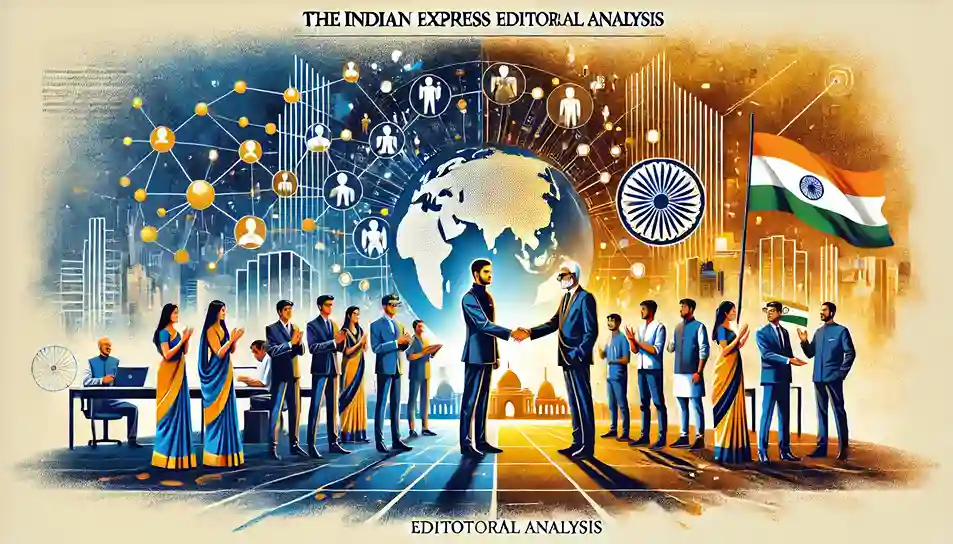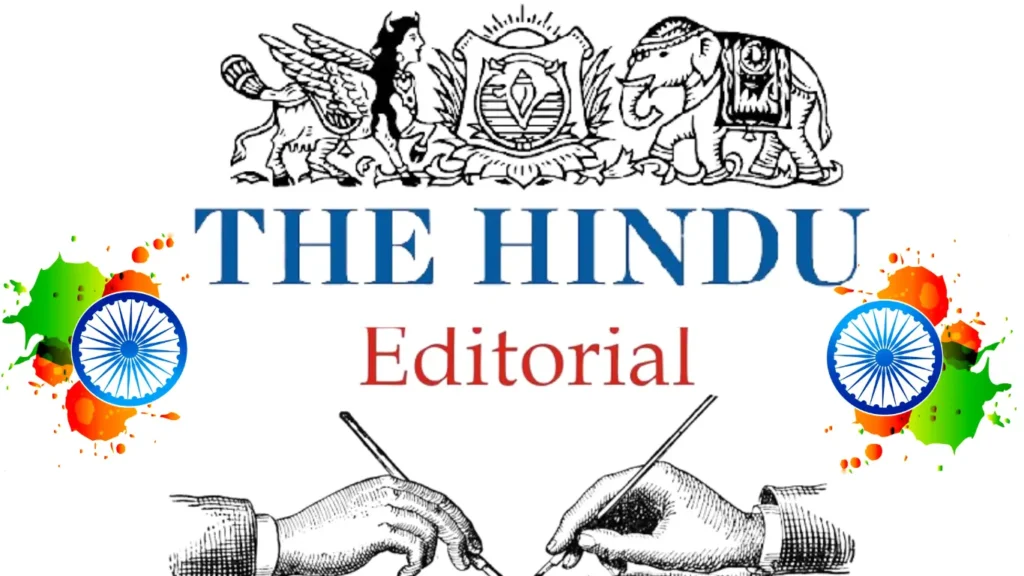Analysis of The Hindu Editorial 1: Shed the myopia, refocus on the relevance of English
Context
The government should prioritize English not as a rival to Indian languages but as an essential tool for both national and international communication.
Introduction
For many Indian parents, ensuring their children are fluent in English is a common aspiration, as it opens doors to better socioeconomic opportunities. However, national education policies have consistently overlooked English for over 70 years, limiting access to its benefits.
The Impact of the National Education Policy (NEP) 2020 on English
Politicization of Education: Since independence, education policies, including NEP 2020, have been influenced by political ideologies, aiming to curb the spread and importance of English.
- Role of English in Nation Building: English remains a neutral language as recognized by the Indian Constitution, ensuring its importance for equality and national cohesion.
- Economic Barriers: Restrictive policies have hampered the economically disadvantaged from mastering English, perpetuating socio-economic inequality.
- Marginalization of Government School Students: The lack of focus on English has deepened the educational divide, disproportionately affecting marginalized students.
- Rich vs. Poor Divide: While affluent families can afford quality English education, the majority of Indians are left behind, widening social gaps.
- English on the Sidelines: The 2011 census shows that 90% of Indians don’t speak any English, highlighting the failure of educational policies to make the language accessible.
- NEP 2020’s Devaluation of English: By labeling English as foreign, the NEP 2020 overlooks its critical role in the global economy.
- Lack of Strategy: The absence of a clear plan to improve English proficiency among disadvantaged groups worsens the educational gap.
- [PDF] International Law by Jan Klabbers –3rd Edition

- [PDF] Shankar IAS Environment 10th Edition Free Download
![[PDF] Shankar IAS Environment 10th Edition Free Download](https://savepdf.in/wp-content/uploads/2025/04/PDF-Shankar-IAS-Environment-10th-Edition-Free-Download-1040x650.png)
- [PDF] “Arihant Computer Awareness Book 1” – Free Download
![[PDF] Arihant Computer Book.pdf” – Free Download for Competitive Exams](https://savepdf.in/wp-content/uploads/2025/04/PDF-Arihant-Computer-Book.pdf-–-Free-Download-for-Competitive-Exams-1040x650.webp)
- [PDF] – Basic Horticulture – Free PDF Download
![[PDF] Basic Horticulture Free PDF Download](https://savepdf.in/wp-content/uploads/2025/02/PDF-Basic-Horticulture-Free-PDF-Download-1040x650.jpg)
- Analysis of The Indian Express Editorial – February 13, 2025

Hidden Agendas in NEP 2020
The three-language formula in NEP 2020 appears to promote linguistic diversity but aims to re-establish Hindi as the primary language, marginalizing English in the process. This conflicts with millions who see English as a means for socio-economic mobility and undermines the Constitution, which enshrines Hindi and English as co-official languages.
The Constitutional Framework
The Indian Constitution balances English as a tool for national and global communication, while safeguarding regional languages. This delicate balance is at risk if English is marginalized.
Navigating Linguistic Challenges
NEP 2020 risks reigniting old linguistic conflicts, instead of promoting English alongside regional languages. Acknowledging these constitutional challenges can guide India toward a more inclusive language policy.
Growing Demand for English
Since economic liberalization in 1991, English has become essential for global economic participation. Ignoring this reality, as past governments have done, hinders India’s growth.
- Marginalizing English: NEP 2020 gives disproportionate focus to regional languages, fueling identity politics and stifling the spread of English.
- Imposing Hindi: The real issue lies in the push to position Hindi as the national language, limiting English access among the masses.
Historical Anti-English Sentiment
Post-independence efforts to promote Hindi aimed to diminish the role of English, despite its official status. This push was driven by the belief that Hindi could unify the nation, a belief that has not aligned with India’s multilingual reality.
- The Three-Language Formula: Introduced in 1968, it aimed to spread Hindi but faced resistance from states like Tamil Nadu, which viewed it as an imposition.
- NEP 2020’s Continuation of Bias: Although it claims flexibility, NEP 2020 continues to prioritize Hindi, lacking the infrastructure to genuinely promote multilingualism.
- Cultural and Political Motivations: By focusing on Hindi and Sanskrit, NEP 2020 overlooks the importance of English, crucial in education, law, and commerce.
A Pragmatic Way Forward
China, recognizing the global importance of English, mandates its study. In contrast, India’s lack of a clear English language policy could hinder its global engagement and social mobility.
India needs a two-language formula that includes a regional language and English to meet the aspirations of its citizens. This would allow broader participation in the global economy while preserving cultural identities.
Conclusion
The government must focus on English as an essential tool for national and international communication, without pitting it against Indian languages. This balanced approach will promote equality, ensuring that all citizens can thrive in a globalized world. English is key to making India more inclusive and globally competitive.
Analysis of The Hindu Editorial 2: In Wilmington, juxtaposing immediacy with legacy
Context
The fourth Quad Leaders’ Summit is a pivotal moment to evaluate the alliance’s progress in ensuring peace and stability in the Indo-Pacific region.
Introduction
On September 21, leaders from Australia, India, Japan, and the United States will gather in Wilmington, Delaware, for the fourth Quad summit. This meeting, marking a full-circle journey since their first in-person summit in 2021, occurs amid global challenges and leadership changes, set alongside key international forums like the United Nations General Assembly (UNGA) and the Summit of the Future.
Why This Quad Meeting Matters
This summit holds heightened importance, as both U.S. President Joe Biden and Japan’s Prime Minister Fumio Kishida face political transitions. Biden has announced he won’t run for re-election, and Kishida’s party is at risk of losing power. These shifts make it essential for the Quad to solidify its strategies and commitments before new leadership takes the reins. Originally set to be hosted by India, the meeting has shifted to the U.S., reflecting the practicalities of Biden’s busy schedule post-G20.
Focus on Indo-Pacific Integration
Infrastructure and Security: A key goal of this summit is to advance the Quad’s maritime domain awareness (MDA) framework, which is central to regional security, supply chains, and technology partnerships.
- Indian Ocean Expansion: The Indo-Pacific Partnership for Maritime Domain Awareness (IPMDA) now extends to the Indian Ocean, signaling the Quad’s commitment to integrating this vast region into the Indo-Pacific security framework.
- Strengthening International Law: Standardizing regional laws and ensuring accountability for violations of maritime norms are also on the agenda, further reinforcing a rules-based order guided by the United Nations Convention on the Law of the Sea (UNCLOS).
- Quad’s Maritime Legal Dialogue: This summit may see the launch of the Quad Maritime Legal Dialogue, designed to create a robust legal framework to benefit not only the Quad nations but also other Indo-Pacific countries.
- India’s Growing Role: India’s leadership in operationalizing the South Asia program through the Information Fusion Centre-Indian Ocean Region (IFC-IOR) highlights its expanding influence in maintaining a free and open Indo-Pacific.
Tracking Progress and Exploring New Opportunities
- Quad’s Broad Agenda: Spanning 16 working groups, the Quad is tackling critical issues such as climate change, emerging technologies, infrastructure, health, disaster relief, maritime security, and counterterrorism. The Wilmington summit offers leaders a chance to evaluate the progress of these initiatives and outline new strategies.
- Technological Advancements: Key projects under review include the deployment of the Open-Radio Access Network (RAN) in Palau, space-based climate monitoring systems in Mauritius, and the expansion of solar energy projects in the Indo-Pacific islands.
- A Regional Security Benchmark: With growing geopolitical uncertainty, the Quad stands as a vital framework for promoting stability and cooperation in the Indo-Pacific.
The Strategic Outlook
As global supply chains shift away from China, the Quad has a unique opportunity to enhance regional economic resilience and security. The reconfiguration of these supply chains offers the potential for economic growth while fortifying security through diversification. Additionally, the Quad’s response to regional security threats, exacerbated by China’s assertive behavior and ongoing conflicts like the Russia-Ukraine war, underscores the necessity of a unified, proactive approach.
The Path Forward
The Wilmington summit also serves as a precursor to the Summit of the Future, where global leaders will address critical issues like sustainable development, international security, and technological innovation. The Quad’s efforts align with these broader global goals, positioning the alliance as a model for cooperation in the Indo-Pacific.
Conclusion
The Quad has evolved into a cornerstone of regional stability, addressing the Indo-Pacific’s most pressing challenges. As it matures, this summit will likely lay the groundwork for future initiatives, cementing the Quad’s role as a global leader in fostering peace, security, and prosperity.

